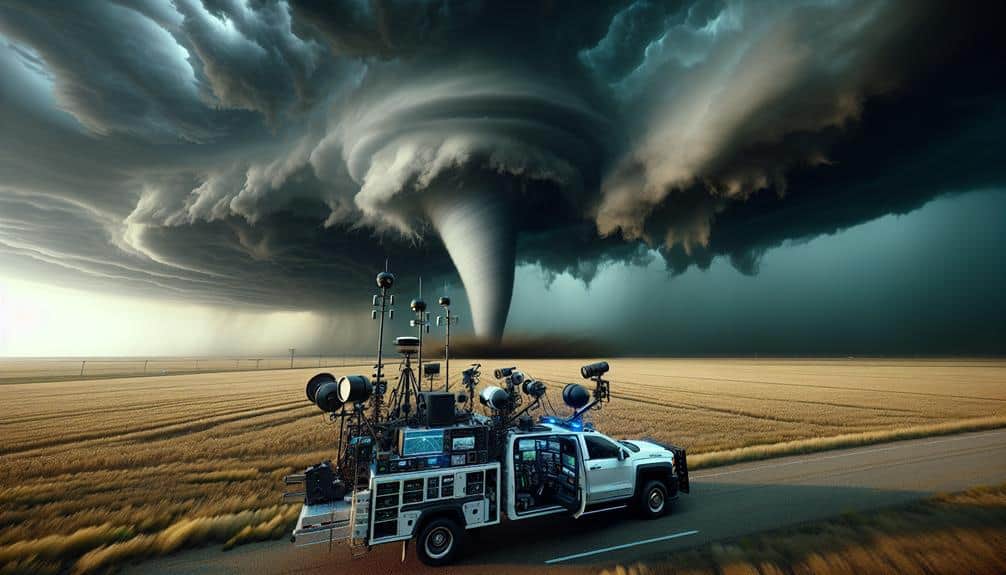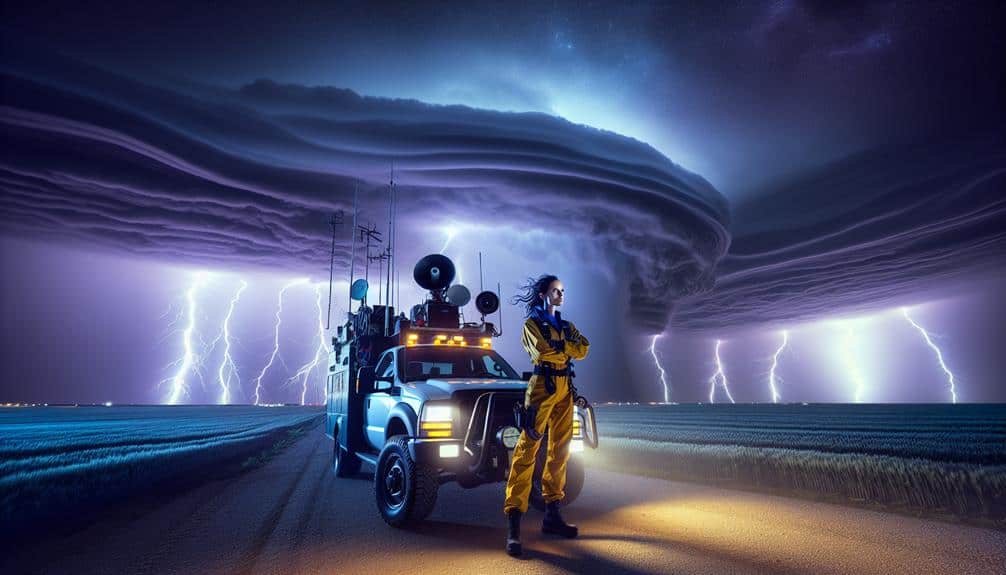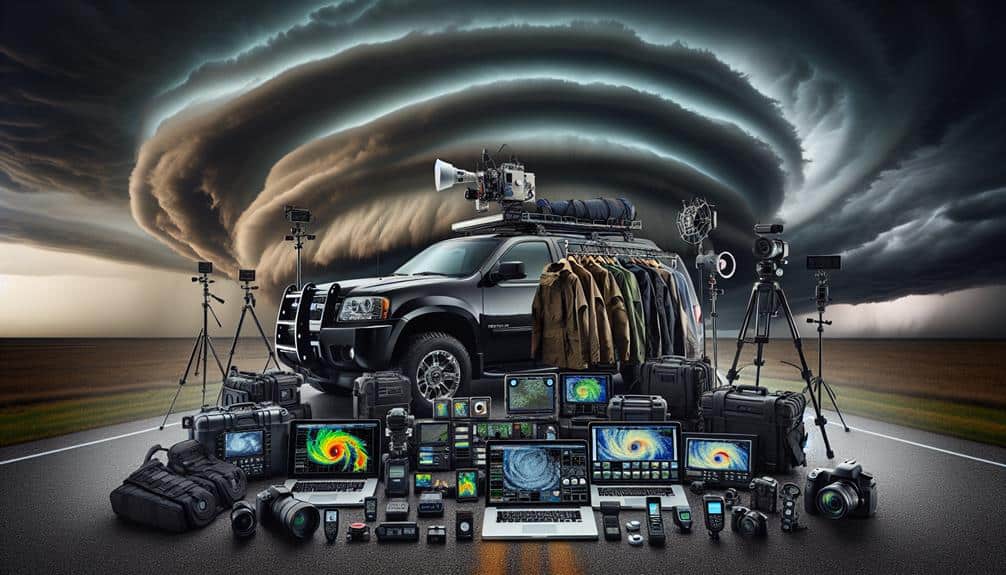Surviving Tornado Alley requires thorough preparation and real-time data analysis. We inspect and calibrate anemometers, barometers, and GPS systems to ensure precise forecasting. High-resolution models and radar guide our positioning, while constant communication via radios and satellite phones keeps us synchronized. Safety gear like reinforced gloves, helmets, and boots are essential, along with emergency supplies in each vehicle. We analyze Doppler radar signatures, wind shear, and pressure drops to identify tornado genesis zones. Advanced radar systems, GPS, and real-time data apps enhance our navigation and observations, critical for safety and efficiency. With these principles, expert storm chasers can optimize their approach.
Key Points
- Prioritize Safety Gear: Equip yourself with high-quality helmets, reinforced gloves, and sturdy boots to ensure personal safety in extreme conditions.
- Utilize Advanced Technology: Use high-resolution radar, GPS, and mobile internet for real-time data analysis and storm path forecasting.
- Maintain Communication: Keep constant contact with your team using radios, satellite phones, and mobile data for real-time updates and safety check-ins.
- Analyze Meteorological Data: Interpret Doppler radar signatures, wind shear metrics, and pressure drops to predict tornado formation and behavior.
Preparing for the Chase
Before embarking on a storm chase, we make certain our equipment is thoroughly inspected and calibrated. Accurate data collection is crucial, so we examine our anemometers, barometers, and GPS systems for peak performance. Precision in calibration guarantees we can depend on our instruments during high-stakes moments.
Our chasing strategies are carefully planned. We analyze meteorological data, focusing on wind shear, humidity, and instability indices to forecast storm paths. By utilizing high-resolution models and real-time radar, we can make informed decisions on positioning. This data-driven approach optimizes our chances of intercepting significant weather events while reducing unnecessary risks.
Communication plans are another foundation of our preparation. We use a combination of radio frequencies, satellite phones, and mobile data to maintain constant contact with our team. This redundancy ensures that even in areas with poor cellular coverage, we stay connected. We establish predefined check-in intervals and emergency protocols to keep everyone informed and safe.
Essential Safety Gear
Equipped with high-quality helmets, reinforced gloves, and sturdy boots, we prioritize personal safety to withstand the extreme conditions encountered during storm chasing.
Ensuring the integrity of our gear is paramount, hence consistent gear maintenance is a non-negotiable practice. We routinely inspect our equipment for wear and tear, replacing any compromised items to guarantee peak performance.
In addition to protective clothing, our emergency supplies are meticulously curated. Each vehicle is stocked with first aid kits, fire extinguishers, and blankets. These supplies are essential for addressing any immediate injuries or adversities faced in the field. Besides, we make sure we've a reliable source of food and water, enough to last at least 72 hours.
Communication devices are our lifeline. Utilizing VHF/UHF radios, GPS units, and satellite phones, we maintain constant contact with our base and fellow chasers. These devices enable real-time weather updates and coordination, essential for making informed decisions.
Sturdy boots with high traction and waterproof capabilities, along with weather-resistant clothing, provide an additional layer of protection. By investing in top-tier safety gear and maintaining it diligently, we maximize our chances of successfully navigating the perilous environments of Tornado Alley.
Traversing Tornado Alley demands precise real-time data analysis and strategic decision-making to anticipate storm patterns and avoid hazardous situations. As storm chasers, we use advanced radar systems, GPS, and mobile internet to stay updated on changing weather conditions. Our ability to interpret meteorological data, such as Doppler radar signatures and wind shear metrics, is essential for effective storm spotting.
Real-time weather feeds and storm prediction models provide us with the necessary information to plot our routes and adjust our positions dynamically.
We depend on storm spotting networks and communication with other chasers to gain insights into localized weather conditions. This collaborative effort allows us to triangulate tornado formations more accurately and predict their paths. High-resolution satellite imagery and weather apps with real-time alerts help us monitor storm cells and make informed decisions quickly.
Navigating Tornado Alley also involves understanding the topography and road networks. We must be aware of escape routes and potential obstacles. Our vehicle's mobility and fuel efficiency are optimized to make sure we can maneuver swiftly and safely.
Observing Tornado Behavior
To effectively observe tornado behavior, we analyze key indicators such as rotational velocity, debris signatures, and pressure drops using advanced meteorological instruments. Our ability to accurately interpret these signs is pivotal for understanding tornado patterns and refining our chasing techniques.
First, rotational velocity offers insights into the storm dynamics. By measuring the speed and direction of winds within the storm using Doppler radar, we can identify potential tornado genesis zones.
Second, debris signatures, visible on radar as distinct patterns, help us confirm the presence of a tornado on the ground. These signatures occur when the tornado lofts debris into the air, indicating its path and intensity.
Third, rapid pressure drops are a direct indicator of tornado formation. By using barometers, we can detect these pressure changes, which often precede a tornado's touchdown.
Here's how we approach our observations:
- Deploy mobile Doppler radar units: These provide real-time data on rotational velocity and storm structure.
- Utilize unmanned aerial vehicles (UAVs): UAVs equipped with cameras and sensors help us capture debris signatures from a safe distance.
- Record barometric pressure readings: Portable weather stations allow us to monitor pressure drops on the move.
Post-Storm Recovery Tips

In the aftermath of a tornado, our priority is to systematically assess structural damage and safeguard the safety of affected communities through rapid response and effective communication.
First, we need to conduct a thorough inspection of buildings, identifying compromised structures to prevent further casualties. Using drones and GIS mapping, we can efficiently document damage and prioritize areas needing immediate attention.
Emergency supplies are critical. We should establish distribution points for essentials like water, food, and medical kits. Securing these supplies are accessible enables us to address urgent needs swiftly, facilitating the initial recovery phase.
Rebuilding homes is a monumental task; it requires coordination with local authorities and construction experts. We must adhere to updated building codes to enhance future resilience. Timely debris removal and securing temporary shelters expedite this process, helping communities regain stability.
Mental health is paramount in post-storm recovery. Organizing support groups and providing access to counseling can mitigate trauma effects. Community support networks strengthen resilience, offering emotional and logistical aid.
Our collective effort in these areas guarantees not only recovery but also the empowerment of communities, fostering a spirit of independence and resilience in the face of adversity.
Frequently Asked Questions
How Do I Join a Storm Chasing Team?
To join a storm chasing team, we must research groups emphasizing safety protocols and strong team dynamics. Attending relevant meteorology courses and networking with professionals enhances our skills and aligns us with teams valuing freedom and precision.
What Qualifications Are Needed to Become a Professional Storm Chaser?
Only 10% of storm chasers have formal meteorology degrees. To become professional storm chasers, we need training requirements like meteorology courses, and necessary skills such as data analysis, storm prediction, and advanced driving techniques.
Are There Any Legal Restrictions on Storm Chasing?
We must consider legal implications and consequences when storm chasing. There aren't specific laws against it, but safety measures and precautions are essential. Ignoring them could result in fines or endangering lives, limiting our freedom to chase.
How Can I Get Real-Time Weather Updates During a Chase?
Even without a cell signal, we've got options. Use weather alerts apps for updates, and employ satellite tracking or drones for real-time data. These tools enhance our freedom to safely navigate unpredictable storm conditions.
What Should I Do if My Vehicle Gets Damaged During a Chase?
If our vehicle gets damaged during a chase, we should prioritize safety precautions. Guarantee everyone's safe first. Then, contact vehicle insurance for repairs. Always have a backup plan, including emergency contacts and alternative transport options.


